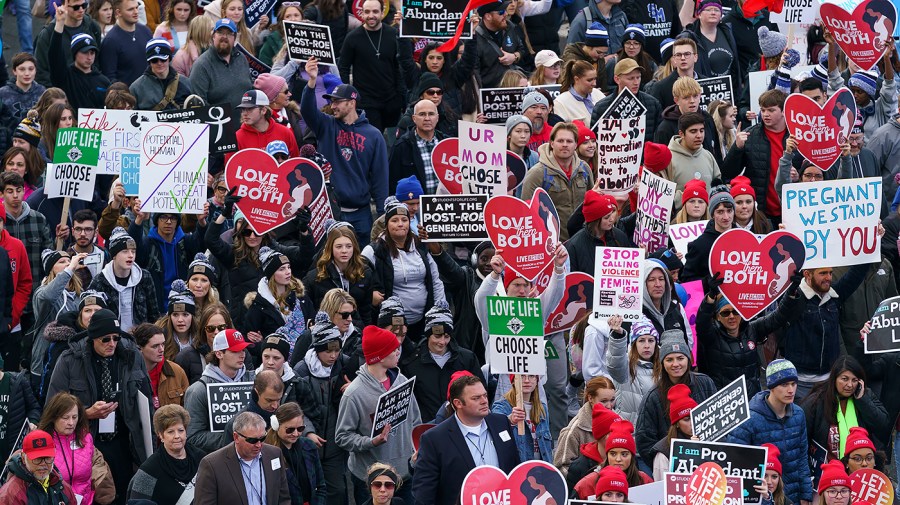I once heard a story (which may or may not be true) about a state legislator who, in the pre-Dobbs era, voted pro-life primarily because it was politically beneficial. But since his heart was never really in it, and because the Supreme Court precedents in place at the time precluded substantial limits on abortion, he didn’t trouble himself to learn very much about the issue. One day on the floor of the legislature, he rose to speak on behalf of a pro-life bill, and looking down to read (for the first time) the talking points prepared by his staff he simply announced to the chamber, without any context or qualification, “I am for rape and incest.”
As horrifying as this story is — and whether it really happened or not — there is an important lesson in it for those of us who wish to change hearts, minds, and ultimately public policy on the question of abortion in the wake of the Dobbs decision. It has been a turbulent first year of real successes, but also significant setbacks, for the pro-life movement. For those of us who affirm the intrinsic and inalienable equal dignity of every member of the human family, born and unborn, we must do better in making the case in the public square for a culture of life and civilization of love as a necessary pre-requisite to wise, just, and humane self-governance in a post-Roe world.
To that end, here are a few modest suggestions for moving forward.
First, it is essential to speak clearly about what, precisely, Dobbs decided. A majority of justices reasonably concluded that no interpretation of the Constitution faithful to its text, history, or the American legal tradition precluded the political branches of government from enacting laws and policies on abortion via the democratic process. The American people had enjoyed this authority since the nation’s founding up until January 22, 1973. Outside of the U.S., nearly every nation in the world regulates abortion through the political process (the vast majority of which restricts abortion after 12 weeks of pregnancy, subject to various exceptions). Dobbs was thus not an arrogation of power by the Court; to the contrary, it was a vanishingly rare instance of the judicial branch devolving authority to the people. It was the opposite of an “anti-democratic” decision.
Second, and more important, it is essential to explain why we are pro-life, and what this means for law and policy. It is not simply being “anti-abortion” (despite what journalistic stylebooks might say). Yes, it involves the legal protection of the unborn from abortion. But this simply follows from the deeper animating principle that every human being has equal matchless dignity and worth, and deserves love, support, and the basic protection of the law. The human context in which the question of abortion arises is thus not a zero-sum “vital conflict” among strangers, but rather a sometimes tragic crisis involving a mother and her child that requires us all to come to their aid and do everything we can to support them both (along with the child’s father, family, and community), before, during and after the child is born.
Put another way, building a culture of life is about enlarging the boundaries of the moral and legal community. It is a matter of addition, not subtraction. It is about building a world in which everyone counts; everyone has a claim on our care — especially the weakest and most vulnerable.
In public debate, we should draw civil but sharp distinctions between this vision for our shared life together with the competing approach. Press those on the other side to answer if they are willing to countenance any hard limits on elective abortion at any gestational stage or for any reason (e.g., sex-selection or to prevent the birth of a child with disabilities). For their part, the media should ask such questions as well.
But to build a culture of life, it is not enough simply to persuade our pro-choice friends and neighbors to revisit long and closely held views. We must open our minds to new political approaches, partnerships, and the role of government in the name of pursuing the most effective and supportive outcomes for mothers, children and families. Build on the progress of “red” states that have expanded Medicaid postpartum coverage from 60 days up to 12 months, enlarged state-level tax credits for children, enacted paid maternity leave for state employees, and authorized significant funding increases for programs and nonprofits providing support for mothers and children.
We must reach across the political divide to create even stronger networks of support for mothers, babies and families, even as disagreements on abortion persist. In “blue” states that have passed new laws expanding access to abortion, we must work for measures providing commensurate support for women and families who choose to parent or make adoption plans for their children.
There is much to do, but there are reasons for optimism. A January 2022 Marist poll, sponsored in partnership with the Knights of Columbus, showed that 81% of respondents agreed that “it is possible to have laws which protect both the health and well-being of a woman and the life of the unborn.” The same question was asked in January of 2023 — seven months after the Dobbs decision — and support for this proposition had risen to 90%.
O. Carter Snead is Professor of Law and Director of the de Nicola Center for Ethics and Culture at the University of Notre Dame and author of “What It Means to be Human: The Case for the Body in Public Bioethics.”
